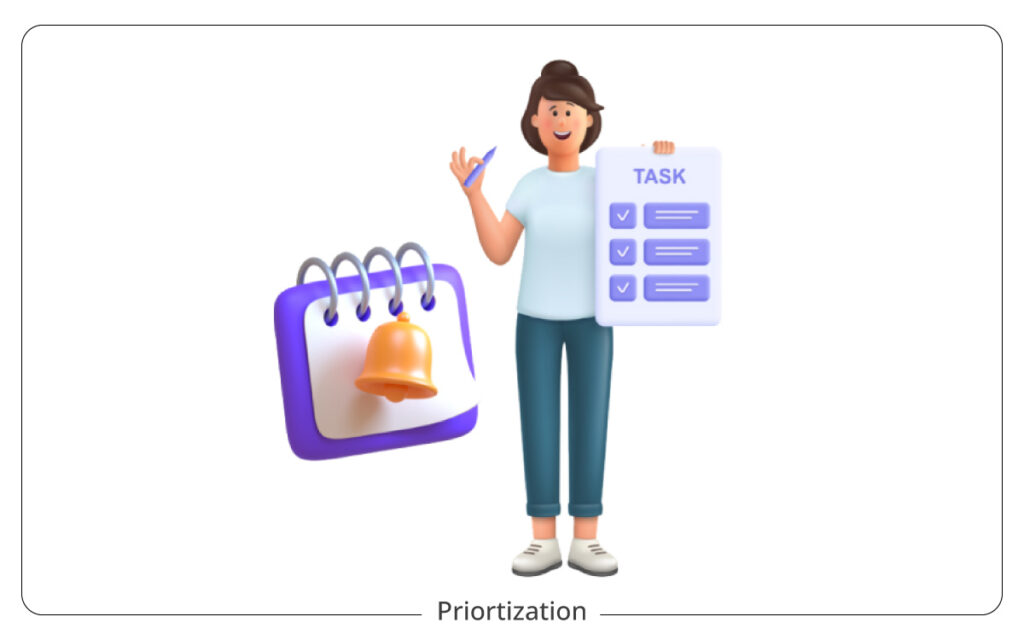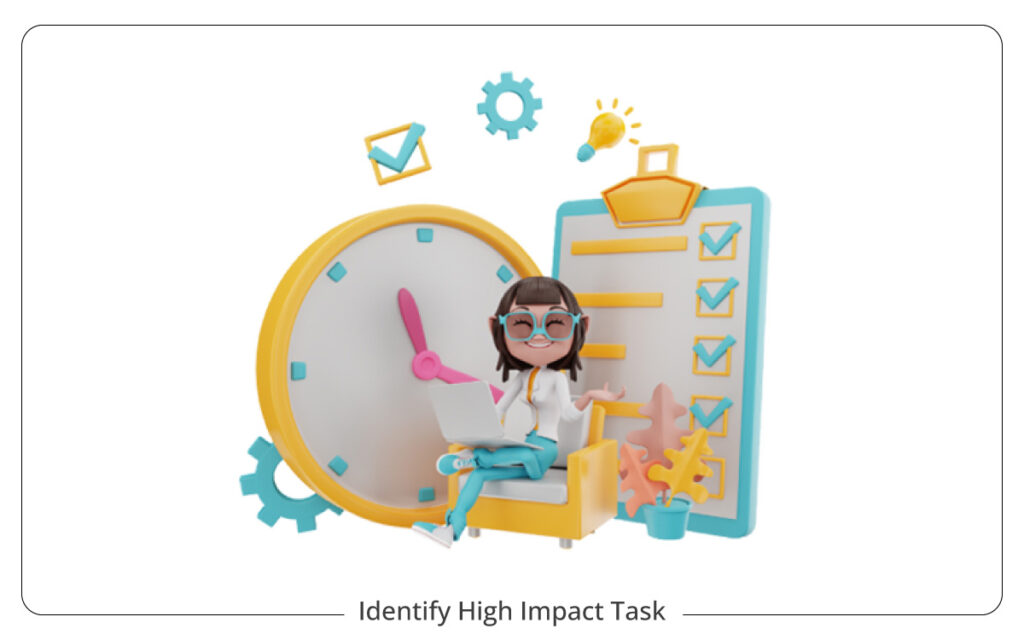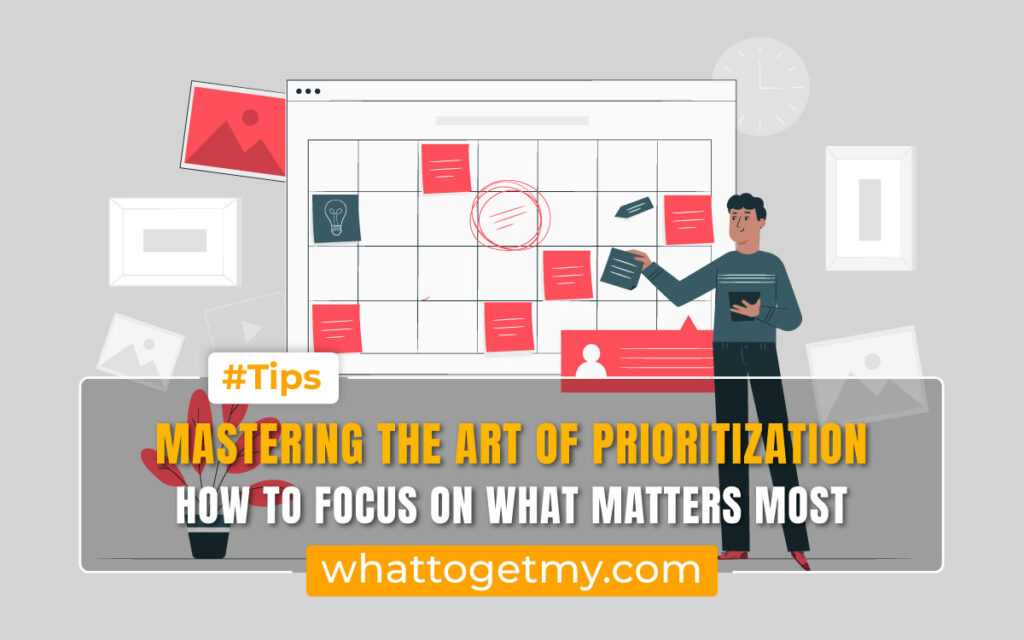5 Tips To Mastering the Art of Prioritization: How To Focus on What Matters Most in 2023
In the world of instant coffee and constant deadlines, it often feels like there needs to be more time to accomplish everything on our to-do lists.
Prioritization determines the order or importance of tasks, goals, or activities based on their significance and potential impact.
Focus is a crucial component of effective prioritization. When you can concentrate your attention and energy on the tasks and goals that truly matter, you increase your chances of success.
Effective prioritization is key to professional success. By identifying and focusing on high-impact tasks and projects, you can deliver exceptional results, gain recognition for your contributions, and advance your career.
Without a transparent prioritization system, it’s easy to get overwhelmed, lose focus, and experience a lack of progress.
In the world of instant coffee and constant deadlines, it often feels like there needs to be more time to accomplish everything on our to-do lists. We find ourselves juggling multiple tasks, goals, and responsibilities, needing help to keep up with the relentless demands of our personal and professional lives. But what if there was a way to regain control, focus on what truly matters, and achieve tremendous success and satisfaction? The answer lies in mastering the art of prioritization.
I. Understanding Prioritization Techniques
A. Prioritization and its role in personal and professional success
Prioritization is evaluating and assigning importance to tasks, goals, or activities based on their significance and impact. It involves making deliberate choices about where to direct your time, energy, and resources. Effective prioritization is a fundamental skill in achieving personal and professional success. By consciously determining what deserves your attention and effort, you can maximize productivity, progress toward your objectives, and maintain control amidst competing demands.
B. The importance of effective prioritization techniques for achieving goals
Without a transparent prioritization system, it’s easy to get overwhelmed, lose focus, and experience a lack of progress. Effective prioritization techniques are crucial for achieving goals because they enable you to:
– Identify and focus on high-impact tasks or goals aligning with your vision and objectives.
– Allocate your time and resources efficiently, optimizing productivity and avoiding time wasted on low-priority or non-essential activities.
– Make informed decisions about task sequencing and resource allocation, ensuring you tackle the most critical and time-sensitive tasks first.
– Reduce stress and overwhelm by providing a structured framework for managing multiple responsibilities.
C. Prioritization methods and principles
To help you master the art of prioritization, let’s explore a range of techniques, methods, and principles:
1. Prioritization techniques for success
– ABC analysis: Categorize tasks into three groups—A (high priority), B (medium priority), and C (low priority)—based on their importance and urgency.
– Eisenhower Matrix: Divide tasks into four quadrants based on their urgency and importance, including “Urgent and Important,” “Important but Not Urgent,” “Urgent but Not Important,” and “Not Urgent and Not Important.”

2. Key principles of prioritization:
– Pareto Principle: Also known as the 80/20 rule, it states that 20% of your efforts often yield 80% of the results. Focus on the tasks that have the most significant impact.
– Timeboxing: Allocate specific time blocks for different tasks or activities, allowing you to work on them with dedicated focus and discipline.
3. Prioritization methods for better time management:
– Pomodoro Technique: Work in focused bursts of 25 minutes, known as Pomodoros, followed by short breaks. Prioritize tasks within each Pomodoro session to make the most of your time.
– The Value vs. Effort Matrix: Plot tasks on a matrix based on their value (benefit, impact) and effort required. Focus on tasks with high value and low effort.
By incorporating these prioritization techniques, fundamental principles, and methods into your daily routines, you can enhance your ability to make informed decisions, manage your time effectively, and achieve your goals more efficiently.
In the next section, we will delve deeper into prioritization strategies for focus and productivity, exploring how to improve your ability to concentrate on priorities and optimize your overall productivity.
II. Prioritization Strategies for Focus and Productivity
A. The significance of focus in prioritization
Focus is a crucial to effective prioritization. When you can concentrate your attention and energy on the tasks and goals that truly matter, you increase your chances of success. Focus allows you to eliminate distractions, stay on track, and make significant progress toward your objectives. By sharpening your ability to focus on priorities, you can optimize your time, maintain momentum, and achieve outcomes that align with your vision and values.
B. Strategies for improving focus on priorities
To master the art of focusing on priorities and effectively prioritizing tasks and goals, consider the following strategies:
1. Set clear goals: Clearly define your objectives and break them into actionable tasks. A clear target helps you focus your efforts and make informed choices about which tasks deserve immediate attention.
2. Identify high-impact tasks: Determine the tasks that will significantly impact your desired outcomes. By identifying these high-impact tasks, you can allocate your resources and efforts accordingly, ensuring that your focus is on the activities that truly move the needle.
3. Practice single-tasking: Multitasking can be counterproductive and diminish your focus. Instead, practice single-tasking by dedicating your attention to one task. This approach allows you to immerse yourself fully in the task and deliver higher-quality results.
4. Use time-blocking: Allocate specific time blocks on your schedule for working on specific tasks or groups of tasks. By assigning focused periods to your priorities, you create a structure that promotes deep work and minimizes distractions.
C. Techniques to boost productivity through effective prioritization:
Effective prioritization goes hand in hand with productivity. You can maximize your productivity and increase efficiency by aligning your efforts with your priorities. Consider the following techniques to boost your productivity through effective prioritization:
1. Prioritization strategies for productivity:
– Eat That Frog: Start your day by tackling the most challenging or important task, also known as “eating the frog.” Completing the most demanding task early, sets a positive tone for the rest of the day and maintains momentum.
– Daily/Weekly planning: Plan your daily or weekly tasks and priorities. This practice helps you stay organized, visualize your goals, and allocate your time effectively.
2. Effective prioritization for increased efficiency:
– Regularly review and reassess priorities: Priorities can change over time, so reviewing and reassessing them regularly is crucial. This practice allows you to adjust your focus based on shifting circumstances, ensuring you remain aligned with your goals.
By incorporating these strategies and techniques into your prioritization approach, you can enhance your ability to focus on what truly matters and increase your overall productivity. The following section, will explore prioritization skills for personal and professional growth, helping you unlock your potential and achieve meaningful progress.
In 2020, the time and attendance sector dominated the workforce management applications market, representing the largest share, according to Statista. It accounted for approximately $2.4 billion in revenue, experiencing nearly $700 million growth from 2018 to 2020.
Ⅲ. Prioritization Skills for Personal and Professional Growth
A. The Impact of Prioritization on personal growth and Well-being
Prioritization plays a significant role in personal growth and overall well-being. By effectively managing your priorities, you can experience the following benefits:

1. Reduced stress and overwhelm: Prioritization helps you avoid feeling overwhelmed by focusing on what truly matters. By consciously allocating your time and energy to your priorities, you can reduce stress and create a greater balance in your life.
2. Enhanced productivity and efficiency: Prioritizing tasks allows you to use your resources efficiently, enabling you to accomplish more in less time. This increased productivity boosts your confidence and creates a positive feedback loop for personal growth.
3. Improved decision-making: Prioritization helps you make informed decisions by considering the importance and impact of each choice. It allows you to align your decisions with your values, goals, and long-term vision, facilitating personal growth and self-fulfillment.
B. Provide practical tips for developing prioritization skills
To develop effective prioritization skills, consider implementing the following tips:
1. Define your values and goals: Understanding your core values and long-term goals provides a foundation for effective prioritization. Clarify what truly matters to you and use this knowledge to guide your decision-making process.
2. Break down larger goals into manageable tasks: Big goals can be daunting, but breaking them down into smaller, actionable tasks makes them more achievable. You can consistently progress towards your larger objectives by focusing on these smaller tasks.
3. Use tools and systems: Employ various tools and systems to assist with prioritization, such as to-do lists, project management software, or digital calendars. Find the best methods for you and integrate them into your daily routine.
C. Explore the application of prioritization in professional settings Prioritization is not only essential for personal growth but also has a profound impact on professional success. Consider the following aspects of prioritization in professional settings:
1. Prioritization techniques for personal growth:
In professional settings, prioritization techniques can help you focus on professional development opportunities, such as training programs, skill-building activities, or networking events. You can enhance your knowledge, skills, and career prospects by consciously prioritizing these growth-oriented initiatives.
2. Prioritizing your way to success:
Effective prioritization is key to professional success. By identifying and focusing on high-impact tasks and projects, you can deliver exceptional results, gain recognition for your contributions, and advance your career.
Remember, mastering prioritization skills in both personal and professional contexts empowers you to achieve personal growth, maintain work-life balance, and progress towards your goals. In the next section, we will explore the art of prioritizing what truly matters and its role in decision-making.

Ⅳ. The Art of Prioritizing What Truly Matters
A. The concept of identifying and focusing on what matters most:
At its core, prioritizing what truly matters involves conscious identification and focus on the activities, tasks, and goals that align with your values, aspirations, and long-term vision. It requires a deep understanding of your personal and professional priorities and the ability to choose where to invest your time, energy, and resources.
B. The benefits of aligning priorities with values and long-term goals
When your priorities align with your values and long-term goals, several benefits arise:
1. Enhanced fulfillment and satisfaction: When you prioritize activities that resonate with your core values and contribute to your long-term goals, you experience a greater sense of fulfillment and satisfaction. This alignment brings a deeper meaning and purpose to your endeavors.
2. Increased motivation and focus: Aligning priorities with values and long-term goals provides intrinsic motivation and clarity. It enables you to maintain focus, persevere through challenges, and remain committed to tasks and projects that truly matter to you.
3. Improved work-life balance: By consciously prioritizing what truly matters, you can strike a healthier work-life balance. You allocate time and attention to personal and professional priorities, fostering overall well-being and reducing burnout.
C. Determining and prioritizing what truly matters
To determine and prioritize what truly matters, consider the following guidance:
1. Reflect on your values: Take time to reflect on your values and what is most important to you. Identify the principles and beliefs that guide your life and use them as a compass for decision-making.
2. Set long-term goals: Define your goals and aspirations in various areas of your life, such as career, relationships, health, and personal growth. These goals will help you establish a framework for prioritization.
3. Evaluate impact and alignment: When faced with multiple tasks or opportunities, assess their potential impact and how well they align with your values and long-term goals. Prioritize those that have a higher impact and strong alignment.
4. Practice self-reflection: Regularly engage in self-reflection to assess your priorities and realign them if necessary. This ongoing process allows you to adapt to changing circumstances and focus on what truly matters.
5. Seek work-life balance: Prioritize activities that promote a healthy work-life balance. Consider dedicating time to self-care, relationships, leisure, and other aspects of your life beyond work. This balance contributes to overall well-being and long-term success.
By mastering the art of prioritizing what truly matters, you create a meaningful and purpose-driven approach to decision-making and task management. In the final section, we will conclude our exploration of the art of prioritization and summarize key takeaways.
V. The Power of Prioritization in Decision-Making
A. How prioritization plays a crucial role in effective decision-making
Prioritization is an essential component of effective decision-making. When faced with choices and options, prioritizing allows you to assess their relative importance and impact, enabling you to make informed decisions. By aligning your decisions with your priorities, you ensure your actions are directed toward what matters most and contribute to your overall goals and objectives.
Prioritization in decision-making helps you avoid decision paralysis, where the abundance of choices can lead to indecision and inaction. It provides a framework for evaluating alternatives, considering the potential outcomes, and selecting the most beneficial course of action.
B. Techniques to prioritize choices and options
When it comes to prioritizing choices and options in decision-making, consider the following techniques:
1. The power of prioritization in decision-making
– Weighted decision matrix: Assign weights and scores to different criteria based on their importance and evaluate each choice accordingly. This systematic approach helps you objectively compare and prioritize options.
– Impact vs. effort analysis: Assess the potential impact and effort required for each choice. Prioritize options that offer a significant positive impact with reasonable effort.

These techniques provide structure and clarity in decision-making, allowing you to evaluate choices based on their alignment with your priorities and desired outcomes.
Remember that effective decision-making requires prioritizing choices and considering relevant factors such as risk, feasibility, and resources. By leveraging the power of prioritization in decision-making, you can make choices that align with your priorities and lead to favorable outcomes.
Mastering the art of prioritization empowers you to focus on what matters most, achieve personal and professional growth, boost productivity, and make informed decisions. By understanding the significance of prioritization, exploring various techniques and strategies, and aligning your priorities with your values and long-term goals, you can unlock the full potential of prioritization and experience the transformative power it brings to your life and work.
Ⅵ. Frequently Asked Questions:
Q1: How can I determine my priorities when everything seems important?
A1: When faced with multiple tasks or goals, it can be challenging to determine priorities. Start by reflecting on your values and long-term goals. Consider each task or goal’s potential impact and alignment with your values and long-term vision. Additionally, evaluate the urgency, importance, and feasibility of each item. By considering these factors and making conscious choices, you can determine your priorities and focus on what truly matters.
Q2: What if my priorities change over time?
A2: It is natural for priorities to evolve as circumstances change and new opportunities arise. Regular self-reflection is essential to assess your priorities and make necessary adjustments. Stay open to reevaluating your goals and values periodically. Embrace the flexibility to adapt and realign your priorities to ensure they align with your current aspirations and circumstances.
Q3: How do I feel safe when prioritizing tasks?
A3: Feeling overwhelmed when prioritizing tasks is a common challenge. Break down larger goals or tasks into smaller, manageable steps to address this. Set realistic deadlines and allocate dedicated time for each task. Consider using productivity tools and techniques, such as creating to-do lists or using time-blocking methods. Additionally, practice self-care, including proper rest, exercise, and relaxation, to maintain a balanced mindset and avoid burnout. Remember, prioritization is about focusing on what truly matters, and by taking one step at a time, you can make progress without feeling overwhelmed.
VII. Conclusion
A. The key points discussed in the article
Throughout this article, we have explored the concept of prioritization and its significance in personal and professional contexts. We began by understanding prioritization techniques, including key principles and methods for effective time management. We then delved into prioritization strategies for focus and productivity, highlighting the importance of focus and providing practical techniques to boost productivity through prioritization. Moving forward, we explored prioritization skills for personal and professional growth, emphasizing the impact of prioritization on well-being and success. We also discussed prioritizing what truly matters, and aligning priorities with values and long-term goals. Lastly, we examined the power of prioritization in decision-making, exploring techniques to prioritize choices and options.
B. The importance of mastering the art of prioritization
Mastering the art of prioritization is crucial for achieving personal and professional success. It enables you to make intentional choices, focus on what truly matters, and increase productivity. Prioritization allows you to align your actions with your values, goals, and long-term vision, fostering a sense of fulfillment and satisfaction. By understanding the importance of prioritization and committing to its mastery, you can unlock your potential, make meaningful progress, navigate life’s complexities, and work with greater clarity and purpose.
C. Apply the strategies and techniques discussed
Now, it’s time to take action. I encourage you, as a reader, to apply the strategies and techniques discussed in this article. Reflect on your values and long-term goals, and use them to guide your priorities. Implement practical tips for developing prioritization skills and improving focus on your priorities. Explore different techniques to boost productivity and make informed decisions through prioritization. Embrace the art of prioritizing what truly matters, and witness its positive impact on your personal growth, well-being, and professional success. Consistent practice and adaptation are essential to mastering prioritization and reaping the rewards.
In conclusion, prioritization is not merely a skill but an art that requires conscious effort and practice. By prioritizing what truly matters, you can lead a purposeful and fulfilling life, accomplishing your goals. Embrace the power of prioritization, and let it guide you toward a future of focused action and meaningful accomplishments.
02 HOURS 42 MINUTES
ESTIMATED TIME DESIGNING AND UPLOADING THIS ARTICLE
09 HOURS 12 MINUTES
ESTIMATED TIME RESEARCHING AND WRITING THIS ARTICLE
LOOKING FOR MORE GIFTS?
Try our AMAZING GIFT FINDER TOOL! Find GIFTS with 1 CLICK!
LOOKING FOR MORE GIFTS?
Try our AMAZING GIFT FINDER TOOL! Find GIFTS with 1 CLICK!
LOOKING FOR MORE GIFTS?
Try our AMAZING GIFT FINDER TOOL! Find GIFTS with 1 CLICK!
You Might Also Like

13 Fun Ideas on How to Celebrate 16th Birthday without a Party
13 Fun Ideas on How to Celebrate 16th Birthday Without a Party WhatToGetMy Instructional Article It’s not always easy to decide how to celebrate the 16th birthday. All your friends and family members are talking about parties and crowdy reunions you are not so fond

17 Great Birthday Gift Ideas for 20 Year Old Female
Don’t know what to get a 20 year old for her birthday? Don’t worry, we’ve got you covered in this gift selection. You will find the perfect birthday gift ideas for a 20 year old female. We have also selected the best Christmas gifts for

How to Get Better at Talking to People
How to Get Better at Talking to People WhatToGetMy Instructional Article I get the impression that I am uninteresting. When I chat with people, I feel like I bore them to death and I often find myself struggling to keep conversations alive. I also get
Where to Rest Your Head in Salzburg: The Ultimate Neighborhood Guide
Where to Rest Your Head in Salzburg: The Ultimate Neighborhood Guide Planning a trip to Austria’s musical wonderland? Let’s figure out exactly where you should unpack your suitcase! Picture narrow cobblestone streets where Mozart probably spilled his coffee rushing to a concert—that’s Altstadt for you! This maze of medieval buildings and hidden courtyards feels like

Gifts for Someone Who Is Always Cold
We all have that one friend who is always cold. Like, always. It might be the middle of January or the middle of July, that doesn’t change anything. That one person will be wrapped under layers and layers of clothes and drag a blanket around

Why Do Depressed People Sleep So Much? 7 Facts to Know of
Why Do Depressed People Sleep So Much? WhatToGetMy Instructional Article This article will provide you with answers to the questions of depression and oversleeping, and depression and fatigue. It will also help you understand the subtle differences between the three. Percentage of people in the

27 Places to Go for Your 18th Birthday
27 Places to Go for Your 18th Birthday WhatToGetMy Instructional Article Well now, look who just became 18, look who just became an adult. First of all, congratulations on reaching this milestone. You have just reached the age of freedom and responsibility and the keys
Fun-Filled Memorial Day Weekend in San Diego: Your 2025 Adventure Guide
Fun-Filled Memorial Day Weekend in San Diego: Your 2025 Adventure Guide So, you’re thinking of hitting the San Diego beaches this summer? Smart move, kid! The water’s finally warm enough that your toes won’t turn into popsicles when you dip them in. Pack your sunscreen (trust me, that “natural tan” you’re hoping for is just

DO GUYS LIKE GETTING GIFTS? WhatToGetMy Instructional Article So many women find themselves constantly on the hunt to find out the answers to very important questions when it comes to getting their guy a gift and the questions are, “Do guys like getting gifts?” and

How to Surprise your Boyfriend for No Reason
Guide On How to Surprise your Boyfriend for No Reason WhatToGetMy Instructional Article Ask every girl out there what she wants, and 90% of the time, she’ll say “ways of how to surprise your boyfriend for no reason.” Women are forever combing through magazines, asking



